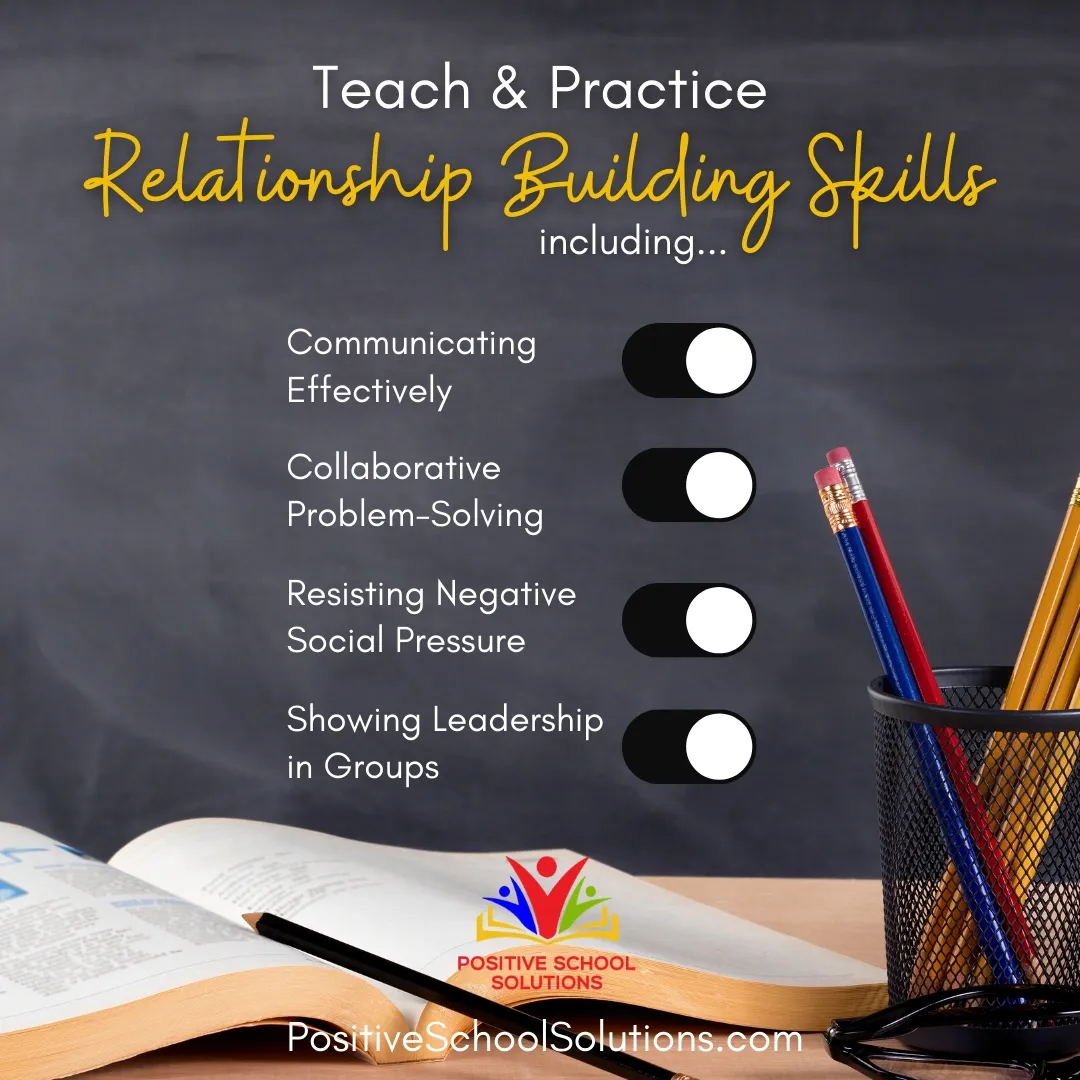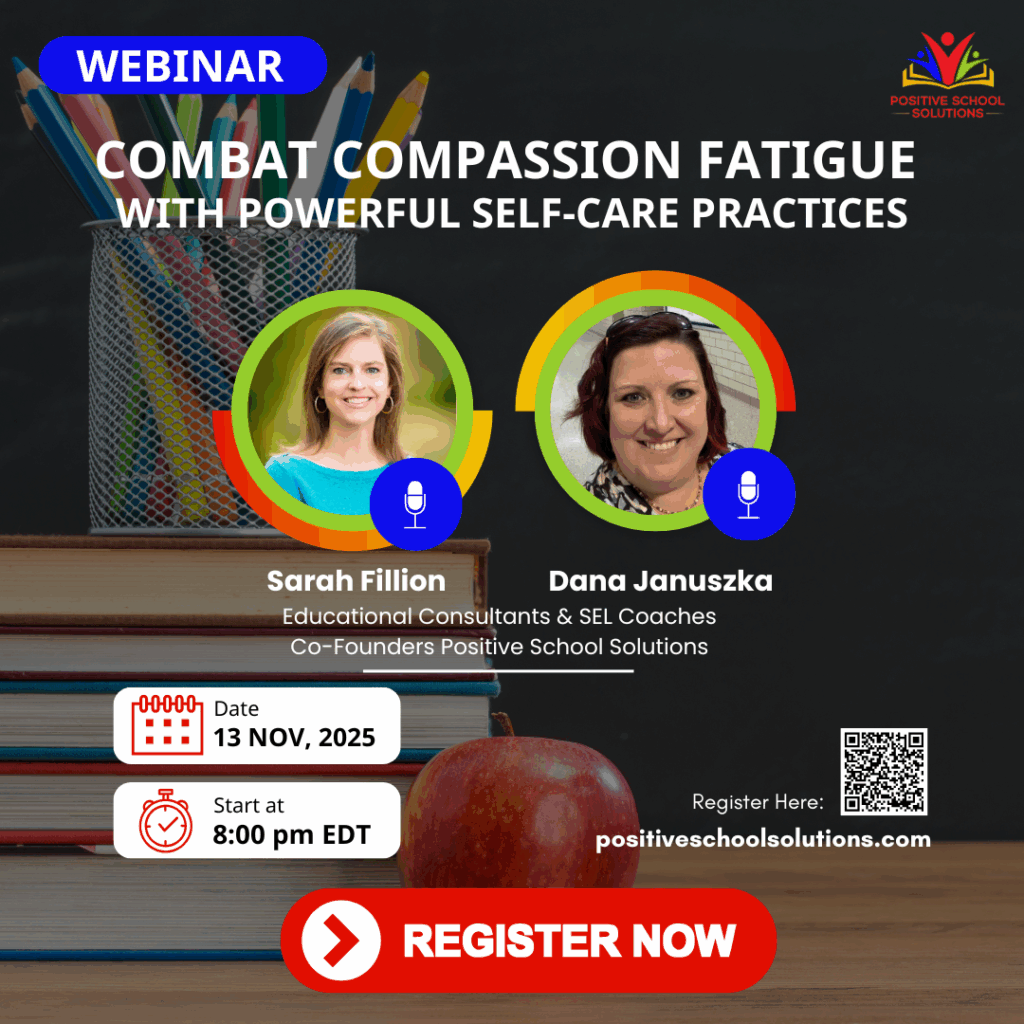So often we tell students to “be nice” to others, “just get along”, or “appreciate the differences” when a student acts in an unkind way. While the sentiment is aligned to how we want them to act, both as children and as adults, it is our responsibility to teach the skills that are necessary to build relationships and provide opportunities to practice those skills in a safe space. 
Building and maintaining positive relationships with others requires many skills to be utilized simultaneously. And, just like relationships increase in complexity through age, an important relationship skill learned early on will require refinement and additional development as students age from kindergarten to seniors. Reteaching these skills, with their added complexity, is essential to supporting students in continued success as they build relationships. Creating space for discussions around the skills ensures they recognize the nuanced changes as part of the development process.
To honor #SELDay, we have used the competencies outlined by the Collaborative for Social and Emotional Learning (CASEL), to align students’ developmental needs to a critical skill that you can explicitly teach- and provided you with ideas on how to teach the skill in an active and interactive way.
Primary
In grades K-2, children are deeply entrenched in learning – learning about school itself, academic skills, and relationships with others. In these critical years, students need guidance, support, and practice of essential skills that will allow them to establish relationships with a diverse group of individuals.
Skill to teach: Communicating effectively
Consider: Anchor charts with sentence stems
Creating anchor charts with visual cues of questions students can use to build relationships can teach students language to engage with others in a clear and effective manner.
Sample questions:
- Hi! Would you like to sit with me at lunch?
- Excuse me, can I join your game of tag?
- Hi (name). Are you looking for a partner? I’ll be your partner.
- My favorite color is ____. What is yours?
- My name is _____. Can you tell me your name?
How to use:
Pulling the class together, tell students that in this class we will be kind to everyone and one we can do that is by asking questions to help us get to know our classmates better. Explain that when we ask a question, we want to make sure the other person knows when it is their turn to talk to answer the question. We will practice asking and answering questions in partnerships and practice using our voice and a pause at the end of the question to help others know we are ready for them to answer. Introduce the anchor chart with questions on it. Partner students up and have them take turns practice asking one another a question and answering it. You can also challenge students to try questions that are not on the list and add them to the chart.
Elementary
As students progress into upper elementary grades, relationship building can be impacted by developmental characteristics such as competitiveness and perceived fairness issues. This timeframe presents an opportunity to focus on relationship skills such as practicing teamwork and collaborative problem-solving to both prevent relationship hiccups and provide strategies for students to resolve situations together.
Skill to teach: Practicing teamwork and collaborative problem-solving
Consider: Scenario cards
Cards with brief scenarios described on them can support students in building skills when used in a well-planned lesson. When the scenarios on each card allow for several appropriate responses, students are provided with an opportunity to discuss in-depth the thinking behind their reasoned thoughts.
How to use:
Create cards with various scenarios that require teamwork or collaborative problem solving. In a small group, students choose a card, read the scenario, and independently think about what they would say in the situation to either practice teamwork or collaborative problem-solving. Once all students in the group have an idea to share, they discuss what their response would be and place the card in one of two piles – teamwork or problem-solving, depending on which strategy the group feels they would use.
Sample Cards:
- As you get ready for recess, you share with a friend that you really want to play kickball today together. Your friend says that they want to play tag.
- The group you are working with on a math assignment has been talking about a movie everyone recently watched and has not gotten started on the work. You look at the clock and see that there are only 10 minutes left to the work period.
- At recess, two of your friends are having a disagreement about which TV show is better and they are no longer playing the game you were all enjoying a few minutes ago.
Middle School
Young adolescents place heavy emphasis on peer relationships, which can make resisting negative social pressure extremely difficult. It is essential to provide students at this age with opportunities to discuss different strategies that can be used to resist peer pressure and allow them to practice these strategies regularly. Creating a safe environment in which students can have serious conversations in a playful manner allows them to recall previously learned skills and engage deeply in the activity.
Skill to teach: Resisting negative social pressure
Consider: Role-play
Role-play is a strategy that can be used to help students generate and practice a variety of responses to challenging situations. Once the scenario is described, students voice their ideas on how to positively navigate the situation and then the teacher (and volunteer students) act on a few of the suggested ideas while the rest of the students observe.
How to use:
- Describe the scenario, making it relatable to the students and applicable to the skill of resisting negative social pressure.
- Pause and invite ideas on how to positively navigate the situation.
- Have volunteers act in a supporting role, while the teacher (or another adult in the room) takes on the role of trying out one of the ideas.
- Alert students to observe carefully; identifying which strategy you used and what they heard and saw.
- Provide time for reflection after the scenario has ended. Observers share what they saw and heard, discuss the possible outcomes of using these strategies in real-life examples, and provide space for students to ask questions or share their thoughts.
- Summarize the main points from the role-play lesson and the various options that students have to resist negative social pressure.
High School
As students progress into high school, they may have had experienced relationship challenges, including friendships ending, jealousy, or discomfort within a group because of behavior and actions. As students mature from young adolescents into young adults, this is a prime opportunity to encourage students to step into positive leadership roles within groups. By emphasizing the importance of building and maintaining healthy and supportive relationships, we can encourage high school students to embrace their passion for change through showing leadership in positive ways.
Skill to teach: Showing leadership in groups
Consider: Four Corner Discussion Groups
How to use:
Have students move to a corner around the room (designate which number each corner is), with students evenly distributed amongst the groupings. Share a scenario in which a group of students needs one person to step into a leadership role. Students in each corner discuss what they might do to show leadership in that situation and come to consensus during their discussion. Once discussions are complete, invite students to step into a leadership role by sharing out a summary from their group. Then, repeat the process by having students move to another corner of the room (or they can opt to stay), again making sure the groups are evenly distributed.
Sample Scenarios:
- In the STEM lab, a group of students are experiencing difficulty with the 3D printer and you recognize what is wrong right away.
- In yoga elective, students clean up their mats haphazardly and they are not stacked neatly. You and two of your friends have lunch next period.
- During chorus, the teacher passes out new sheet music and you notice someone at the end of your row doesn’t have a copy.
- In video production – you can tell a classmate nearby is struggling, based on the noises and facial expressions they are making.
Through taking the time to explicitly teach students essential skills to establish and maintain healthy and supportive relationships, we also teach them how to effectively navigate settings with diverse individuals and groups. Healthy relationships are linked to positive outcomes including strong mental health and longevity, and are the foundation for leading to positive social change, such as equity. With relationships being essential in all aspects of life, it is important that the responsibility of teaching students the necessary skills is seen as a team effort and teachable moments are seized upon in all classes throughout the day. While specific skills may be taught during a specific time or period, the skills are practiced and generalized by students throughout the day and continuously reinforced . As students mature, it is important to revisit previously learned skills, as well as to introduce and practice new skills that will allow for students to build supportive relationships with their peers.
Written by Sarah Fillion and Dana Januszka 2021

